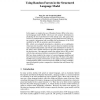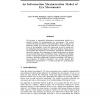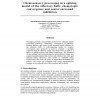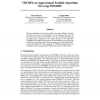NIPS
2004
13 years 5 months ago
2004
In this paper, we explore the use of Random Forests (RFs) in the structured language model (SLM), which uses rich syntactic information in predicting the next word based on words ...
NIPS
2004
13 years 5 months ago
2004
Successful application of reinforcement learning algorithms often involves considerable hand-crafting of the necessary non-linear features to reduce the complexity of the value fu...
NIPS
2004
13 years 5 months ago
2004
We propose a sequential information maximization model as a general strategy for programming eye movements. The model reconstructs high-resolution visual information from a sequen...
NIPS
2004
13 years 5 months ago
2004
This paper presents a neuromorphic model of two olfactory signalprocessing primitives: chemotopic convergence of olfactory receptor neurons, and center on-off surround lateral inh...
NIPS
2004
13 years 5 months ago
2004
We present a discriminative part-based approach for the recognition of object classes from unsegmented cluttered scenes. Objects are modeled as flexible constellations of parts co...
NIPS
2004
13 years 5 months ago
2004
We propose a new set of criteria for learning algorithms in multi-agent systems, one that is more stringent and (we argue) better justified than previous proposed criteria. Our cr...
NIPS
2004
13 years 5 months ago
2004
Existing algorithms for discrete partially observable Markov decision processes can at best solve problems of a few thousand states due to two important sources of intractability:...
NIPS
2004
13 years 5 months ago
2004
We introduce a novel active-learning scenario in which a user wants to work with a learning algorithm to identify useful anomalies. These are distinguished from the traditional st...
NIPS
2004
13 years 5 months ago
2004
Dominant sets are a new graph-theoretic concept that has proven to be relevant in pairwise data clustering problems, such as image segmentation. They generalize the notion of a ma...
NIPS
2004
13 years 5 months ago
2004
Online mechanism design (OMD) addresses the problem of sequential decision making in a stochastic environment with multiple self-interested agents. The goal in OMD is to make valu...





